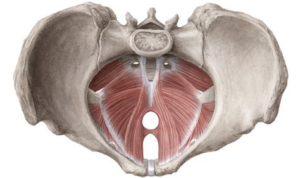
Do you experience leakage during your runs? Frequently find a bush to pee behind or plan your route based off of the public bathrooms in town? Do you experience abdominal cramping during or after running? Increased back pain as you increase your mileage? If you answered yes to any of these questions, you might have pelvic floor dysfunction. These issues are much more common than you think. Thankfully, a lot can be done to help!
Your pelvic floor is a group of muscles that sit at the bottom of the pelvis. They make a hammock to support your pelvic organs – bladder, rectum (bowels), and uterus and/or prostate. These muscles are a part of our “deep core” to also support the spine and hips. Many people think pelvic floor contractions, also known as “Kegels,” are the only solution to improving pelvic floor function. However, this view only looks at a fraction of what these muscles do. In fact, pelvic floor muscles can also be too tense and rigid causing pain as well as bowel, bladder, and sexual issues. A pelvic health physical therapist can perform a pelvic floor assessment to determine what type of pelvic floor muscle program you need. In the meantime, looking north and south of the problem can often reduce pelvic floor issues. Below are some tips for helping out your pelvic floor in different ways other than doing kegels.

Breath: As you inhale, the respiratory diaphragm lowers in your abdomen and the pelvic floor muscles relax gently to accommodate lung expansion in the rib cage. As you exhale, the respiratory diaphragm rises back into the rib cage and the pelvic floor naturally draws upwards. Focusing on your breathing allows your pelvic floor to naturally move like a trampoline to absorb the impact of running.
Form: If your form is putting too much pressure on your pelvic floor muscles, this may be the cause of weakness and subsequent urinary and/or bowel problems. Leaning backward, reduced cadence, too long of strides, and too much bounce can be common culprits of placing excessive demand on your inner core. Stacking the rib cage over the pelvis and addressing any lower-body running mechanics can allow your pelvic floor to work smarter, not harder.
Cross Train: Our pelvic floor plays a very supportive role and it rarely works in isolation. If the pelvic girdle and lower body are weak, the pelvic floor will have to work more to provide extra support to the pelvis. Strengthening the core and hips is not only a great way to minimize injury, but also a great way to protect your pelvic floor from working overtime.
 missoulamarathon.org >>
missoulamarathon.org >>